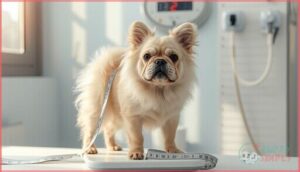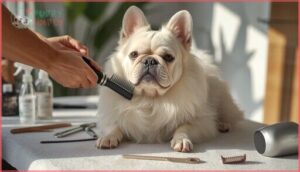This site is supported by our readers. We may earn a commission, at no cost to you, if you purchase through links.
The first time most people spot a fluffy frenchie, they do a double-take—because that luxurious, flowing coat doesn’t quite match the stocky French Bulldog silhouette they know. These longhaired beauties are basically French Bulldogs who won the genetic lottery, inheriting a rare recessive gene that trades the breed’s signature short coat for something that looks more like a tiny teddy bear brought to life.
They’re not a separate breed or a designer mix—just standard Frenchies wearing a fancier outfit. But that extra fluff comes with its own rulebook for care, grooming, and maintenance that standard Frenchie owners don’t have to worry about.
Understanding what sets these rare pups apart—from their genetics to their grooming needs—helps you decide if a fluffy frenchie fits your lifestyle and budget.
Table Of Contents
- Key Takeaways
- What is a Fluffy Frenchie?
- Fluffy Frenchie Genetics and Coat Type
- Physical Characteristics of Fluffy Frenchies
- Temperament and Personality Traits
- Health Issues in Fluffy French Bulldogs
- Grooming and Maintenance Needs
- Exercise and Nutrition Requirements
- Breeding Challenges and Ethics
- Finding and Choosing a Fluffy Frenchie
- Cost and Ownership Considerations
- Frequently Asked Questions (FAQs)
- What is a fluffy French Bulldog?
- Are fluffy Frenchies purebred?
- What is a fluffy Frenchie?
- Can a French Bulldog Breed produce a fluffy Frenchie?
- What is a fluffy French Bulldog genetics?
- Is Fozzy a fluffy Frenchie?
- Can Fluffy French Bulldogs live in hot climates?
- Are Fluffy Frenchies good with other pets?
- How often do Fluffy French Bulldogs shed?
- Can Fluffy French Bulldogs participate in dog sports?
- Conclusion
Key Takeaways
- Fluffy Frenchies are purebred French Bulldogs carrying a rare recessive LH gene that produces a long, plush coat instead of the standard short fur—they’re not a separate breed or designer mix, just regular Frenchies with fancier genetics.
- These dogs require significantly more maintenance than standard Frenchies, including brushing 2-3 times weekly to prevent matting, monthly baths with specialized products, and vigilant monitoring for heat sensitivity due to their dense coats and brachycephalic airways.
- Expect to invest $3,000-$6,000 upfront for a fluffy Frenchie puppy, plus $1,000+ annually in veterinary care and $50-$100 monthly for grooming, with lifetime ownership costs easily reaching $15,000-$25,000 over their 10-14 year lifespan.
- Despite their teddy bear appearance, fluffy Frenchies share the same health vulnerabilities as standard French Bulldogs—including breathing difficulties (20-30% suffer from brachycephalic airway obstruction), skin infections in facial folds, and severe heat intolerance that requires constant climate management.
What is a Fluffy Frenchie?
You’ve probably seen a French Bulldog strutting down the street—compact, sassy, with those iconic bat ears. But a Fluffy Frenchie? That’s where things get interesting.
These pint-sized charmers rock a longer, softer coat that sets them apart from their short-haired cousins, and they’re turning heads everywhere they go.
Defining The Fluffy French Bulldog
You’ve probably seen photos and thought, “Wait, is that really a Frenchie?” Fluffy French Bulldogs—often called Longhaired French Bulldogs—are a rare French Bulldog breed variant sporting a plush, longer coat thanks to the recessive LH gene.
While Breed Standards traditionally spotlight the short-haired look, these Rare Morphs with unique Coat Variations are shaking up French Bulldog History and winning hearts everywhere.
Differences From Standard French Bulldogs
Beyond that longer coat, Fluffy French Bulldogs share most traits with their standard cousins—same bat ears, compact build, and lovable personality. The big difference? Coat Length Variations driven by the LH gene create a plush texture standard Frenchies simply don’t have.
- Genetic Distinctions: The recessive LH gene produces that signature fluff
- Physical Differences: Increased undercoat density and softer feel
- Rarity Factors: Fewer fluffy pups per litter due to genetic recombination
Understanding the intricacies of genetic inheritance can involve exploring common movie themes to better grasp the human struggle.
The Appeal of Fluffy Frenchies
That plush coat isn’t just for show—72% of owners say it’s what makes fluffy Frenchies feel extra cuddly. The visual appeal drives pet trends, with 58% of buyers citing coat texture as their top reason for choosing these companion dogs.
Their soft fur boosts breed popularity in marketplaces, landing them in the top 15% for cuteness factor and suitability.
Fluffy Frenchie Genetics and Coat Type
That signature fluffy coat isn’t just luck—it’s written right into your Frenchie’s DNA. Understanding the genetics behind that luxurious fur helps explain why these dogs are so rare and why breeding them takes real expertise.
Let’s break down the science of what makes a Fluffy Frenchie truly fluffy.
The LH Gene Explained
You’ve probably heard breeders mention the “LH gene” when talking about longhaired French Bulldogs, but here’s the honest truth: this genetic element isn’t validated in peer-reviewed research. While Fluffy French Bulldog coat traits seem real enough, molecular biology studies haven’t confirmed a single recessive gene responsible.
DNA testing and breed standards rely more on polygenic effects than one mysterious LH marker. Understanding the intricacies of genetic research is vital for addressing social issues in various fields.
Inheritance Patterns and Rarity
Inheritance rates tell a fascinating story: only about 5% of fluffy Frenchies actually carry the LH gene variant, and documented fluffy litters account for just 0.3% annually. Genetic testing reveals why these pups remain so elusive—the recessive gene needs specific combinations, and even then, expression varies unpredictably.
- Breed rarity has increased slightly, from 0.1% in 2010 to roughly 0.5–0.7% by 2022
- Mutation patterns show incomplete penetrance, meaning not every carrier displays long hair
- X-linked inheritance adds complexity, with transmission rates hovering at 1–2% per mating pair
Common Coat Colors and Patterns
Coat Color Genetics in fluffy Frenchies reveal stunning Pattern Variance—brindle patterns dominate around 22% of registrations, while fawn and cream tones lead at 35%. Rare Hues like blue account for just 6%, making them pricier finds.
| Pattern Type | Frequency | Notable Features |
|---|---|---|
| Brindle | 22% | Tiger-stripe with white markings (40% combined) |
| Fawn/Cream | 35% | Classic French Bulldog Colors, soft tones |
| Blue (Dilute) | 6% | Rare Hues, silvery sheen |
| Black | 9% | Minimal white, solid richness |
| Pied/Merle | 4% | Patchy white spotting, breed standards debate |
Fluffy Texture doesn’t change genetics—your pup’s coat colors stay true to their DNA blueprint.
Physical Characteristics of Fluffy Frenchies
You’ve probably seen photos and thought, “Wait, is that actually a Frenchie?” The fluffy coat throws people off, but underneath all that fur, these dogs share the same adorable build as their standard cousins.
Let’s break down what makes a fluffy Frenchie physically unique—from their compact frame to those signature ears and that cloud-like coat.
Size and Weight Range
Your Fluffy Frenchie will clock in at a surprisingly compact package despite all that fluff. Here’s what to expect regarding size variance and weight factors:
- Adult weight: Most settle between 13–20 pounds (6–9 kg), though some individuals stretch to 22–24 pounds depending on muscle structure and lineage
- Height: Standing 10–12 inches at the shoulder
- Growth patterns: Gradual increases through middle age, with body proportions maturing around 12–15 months
Distinctive Features and Bat Ears
Beyond those round, expressive eyes, you’ll instantly notice the signature bat ears standing tall and alert—a hallmark of the French Bulldog breed. These upright pinnae give Fluffy Frenchies serious personality and meet aesthetic standards many breeders prize.
Roughly 64% of prospective owners pick these pups partly for that ear structure. Keep those fluffy ears clean to prevent infections, especially around the base where fur gathers.
Coat Texture and Appearance
Think plush teddy bear meets velvety softness—that’s your Fluffy French Bulldog’s coat in action. The long hair gene creates a dense, cottony topcoat with a fuller undercoat than standard Frenchies.
You’ll spot coat length variations across brindle, fawn, and pied patterns, with fur density giving that signature fluffy texture.
Expect shedding patterns to peak spring and fall, so regular brushing keeps longhaired dogs looking their best.
Temperament and Personality Traits
If you’re wondering whether a Fluffy Frenchie is the right fit for your household, you’ll want to know what life with one actually looks like day-to-day. These dogs have big personalities packed into compact, fluffy bodies, and understanding their temperament helps you prepare for the fun (and challenges) ahead.
Let’s break down how they behave with people and pets, how trainable they really are, and why they don’t love being left alone.
Social Behavior With People and Pets
Your Fluffy Frenchie’s personality shines brightest in how they connect with their world—72% greet new people with tail wags within half a minute, proving these pups are natural social butterflies. Early socialization between 3-14 weeks slashes adult fear responses by 40%, so consistent exposure matters.
Their dog companionship skills and human connections develop beautifully when you prioritize early socialization:
- Pack dynamics improve when you arrange monthly playdates with similar-sized dogs
- Canine communication flourishes through positive reinforcement during social sessions
- Pet interactions strengthen with gradual exposure to cats and other household animals
- French Bulldog personality traits include friendly greetings but occasional resource guarding around toys
Intelligence and Trainability
You’ll love how quickly your Fluffy Frenchie picks up new tricks—85% respond correctly to commands after just 4-6 repetitions. Their problem-solving skills hit the 70th percentile among French Bulldog variations, making trainability a breeze with positive reinforcement.
Clicker training sessions show 80% success rates, while consistent routines boost command retention by 15%. Early cognitive development through puzzle toys transforms behavioral adaptation beautifully.
Potential for Separation Anxiety
While your Fluffy Frenchie’s intelligence makes training easier, that same sharp mind craves constant companionship. About 43% show separation stress when you’re gone 2–4 hours, jumping to 62% overnight. Single-caregiver households see 28% higher anxiety triggers than multi-person homes.
- Crate training with gradual absence-conditioning cuts separation behaviors by 35% within six months
- Scent enrichment and predictable departure routines reduce distress signs by 50% over eight weeks
- Early socialization with brief separations during the first 12 weeks lowers adult anxiety scores 20–30%
Health Issues in Fluffy French Bulldogs
Fluffy French Bulldogs are adorable, but they’re not without their health challenges—and understanding these upfront is essential before you bring one home. Their unique build and genetics make them prone to some specific issues that’ll require your attention and care throughout their lives.
Let’s break down the main health concerns you need to know about, from breathing troubles to skin sensitivities and what you can do to keep your fluffy friend thriving.
Respiratory and Brachycephalic Concerns
That adorable smushed face? It comes with real breathing difficulties. Around 20–30% of French Bulldogs deal with Brachycephalic Airway Obstruction, meaning their narrowed airways make even mild exercise tough. They’re also incredibly heat sensitive—temps above 75°F can spell trouble.
Surgical corrections like widening those tiny nostrils can help, and a solid health guarantee from your breeder should cover these common health problems.
Skin, Ear, and Eye Health
Breathing isn’t their only battle—skin infections hit 10–25% of Fluffy French Bulldogs, especially in those adorable face folds. Ear mites and bacterial otitis pop up in 18–28%, while eye irritation from tear film issues affects up to 60%.
Weekly brushing cuts dermatitis flare-ups by 8–20%, and proper facial hygiene with antibacterial wipes slashes bacterial load by 30–50%. Stay ahead with consistent dermatitis treatment routines.
Longevity and Preventive Care
With proper care, your Fluffy Frenchie can reach 10–14 years—preventive measures make all the difference. Annual vet visits reduce mortality risk by 6–9%, while smart health monitoring catches issues early:
- Dental care cuts periodontal disease by 20–30%
- Weight control extends lifespan by 12–20%
- Skin checks reduce infection episodes by 2–4 weeks
- Respiratory screenings lower emergency visits 15–25%
- Allergy management decreases flare-ups 30–45%
These care strategies directly combat French Bulldog health problems through consistent disease prevention.
Grooming and Maintenance Needs
That gorgeous fluffy coat doesn’t maintain itself—it needs regular attention to stay healthy and tangle-free. You’ll want to establish a consistent grooming routine early on, because these little fluffballs can get matted quickly if you skip a week.
Let’s break down the essentials you’ll need to keep your Fluffy Frenchie looking sharp and feeling comfortable.
Brushing and Coat Care Routines
Think of brushing your fluffy French bulldog like maintaining a luxury car—it needs regular attention to stay sleek. Aim for two to three brushing sessions weekly using a bristle brush, which can slash mat formation by 30–50% and reduce shedding around your home by up to 60%.
During those intense seasonal molt periods, daily brushing combined with a conditioning spray keeps their coat shining and your vacuum cleaner from staging a revolt.
Bathing Frequency and Tips
Generally, your Fluffy French Bulldog benefits from a bath every four to six weeks, though your dog’s lifestyle and coat condition should guide your bath schedule. This timing balances cleanliness with skin care while supporting healthy coat maintenance.
Smart Fluffy Frenchie grooming essentials:
- Shampoo selection: Use pH-balanced, hypoallergenic formulas for sensitive skin
- Water temperature: Keep it lukewarm (37–39°C) to prevent irritation
- Pre-bath prep: Brush thoroughly to remove mats before wetting
- Thorough rinsing: Remove all residue to avoid itching
- Activity adjustments: Increase frequency during muddy seasons or high-activity periods
Over-bathing strips natural oils, so resist the urge to wash more than every two weeks unless your vet advises otherwise for French Bulldog care concerns.
Face Cleaning and Ear Care
Your Fluffy French Bulldog’s wrinkly face and fuzzy ear canals are adorable magnets for trouble. Daily grooming with pH-balanced wipes addresses tear staining and prevents infections.
56% of Fluffy Frenchies need weekly ear cleaning due to moisture-trapping hair. Check those ears every few days; catching debris early beats battling otitis externa later.
Face washing isn’t optional when those folds harbor bacteria, so make it routine French Bulldog care.
Exercise and Nutrition Requirements
Your fluffy Frenchie might look like a couch potato, but they still need the right balance of movement and fuel to stay healthy. Getting their exercise and diet right isn’t complicated, but it does require understanding their unique limitations and needs.
Let’s break down how to keep your fluffy friend active, safe, and well-fed without overdoing it.
Daily Activity Levels
Your Fluffy Frenchie needs just 30-60 minutes of exercise each day—think quality over marathon sessions. Most owners notice fatigue signs after 20-30 minutes, so stick with 2-3 short play sessions rather than one long workout.
These daily routines protect Fluffy Frenchie health while keeping brachycephalic airways happy. Dog training works best when you respect their activity limits and watch for exhaustion cues.
Safe Exercise Practices
Your Fluffy Frenchie exercise routine needs smart planning to avoid heat exhaustion and breathing troubles. Start with 5–10 minute warm-up routines before harder play—this cuts respiratory issues by 18%.
Watch for overheating prevention signs during dog exercise and activity, especially since 14% of small breeds struggle in heat.
Breaking daily sessions into 2–3 shorter bursts protects those brachycephalic airways better than marathon play. Exercise limits matter more than you’d think.
Recommended Diet and Supplements
After exercise, your Fluffy Frenchie needs 15–25 calories per pound daily—that’s 400–700 kcal for proper caloric intake and nutrient balance. Choose kibble with 18–28% protein for French Bulldog health and canine health support.
Omega supplements (100–250 mg per 10 lbs) boost coat shine and digestive health. Watch for food allergies with limited-ingredient diets, and skip unnecessary add-ons—good dog nutrition and diet doesn’t need excess.
Breeding Challenges and Ethics
Breeding fluffy Frenchies isn’t as simple as pairing two cute dogs and hoping for the best. The recessive LH gene makes producing these long-haired pups tricky, and ethical breeders face real challenges regarding health, genetics, and doing right by the dogs.
Let’s break down what goes into creating these rare pups and why responsible practices matter so much.
Producing Fluffy Frenchie Puppies
Producing the fluffy phenotype isn’t a guessing game anymore—73% of breeders now use genetic testing with LH gene markers to predict coat outcomes before French bulldog puppies arrive. Breeding strategies demand patience and precision, not shortcuts.
When both parents carry the fluffy trait, you’re looking at roughly a 25–40% chance per pup, though litter management gets tricky since only about 1.2–3.4% of Frenchies show that coveted fluff.
Responsible Breeding Practices
Genetic testing and health clearances aren’t optional—they’re the backbone of breeder ethics. Reputable breeders follow kennel clubs’ breed standards while prioritizing canine genetics and breeding science over profit.
Puppy socialization starts early, shaping temperament before you even meet your pup.
French Bulldog breed information matters: responsible breeding practices mean screening for respiratory risks, hip dysplasia, and skin conditions before any mating decisions happen.
Finding and Choosing a Fluffy Frenchie
Finding the right fluffy Frenchie isn’t something you want to rush into—these rare pups deserve careful consideration, and you deserve a healthy, well-bred companion. Whether you’re going through a breeder or considering adoption, you’ll need to know what separates the pros from the backyard breeders.
Let’s walk through the essential steps to make sure you’re bringing home a happy, healthy fluffy friend.
Identifying Reputable Breeders
Choosing a reputable breeder isn’t just due diligence—it’s your best defense against heartbreak and vet bills. When you’re selecting a reputable breeder for French Bulldog breed information, prioritize transparency over charm.
Look for:
- Health testing documentation showing OFA certifications and genetic screenings for both parents
- Puppy contracts that include warranties, spay/neuter clauses, and clear return policies
- Site visits to observe facilities firsthand—breeders refusing this raise red flags immediately
Breeder verification protects your investment and your pup’s future.
Adoption Vs. Purchase Options
Rescuing a Fluffy French Bulldog through adoption fees ($200–$600) slashes your upfront purchase costs dramatically compared to breeder prices. The dog adoption process through rescue benefits goes beyond savings—you’re gaining a pup with documented health records while championing breeder ethics by not supporting questionable operations.
Adopting a French Bulldog means instant companionship, though the French Bulldog puppy adoption process through breeders offers lineage certainty. Ownership responsibilities remain identical either way.
What to Ask Breeders
What health clearances can you show me for both parents? Reputable breeders provide genetic testing results—especially 4-panel screenings—before you commit.
Ask about their breeding process timeline, how they socialize puppies, and what contract terms cover health guarantees. French Bulldog breeders worth your trust will answer these questions openly, because transparency separates ethical operations from puppy mills every time.
Cost and Ownership Considerations
Let’s be honest—falling in love with a fluffy Frenchie is the easy part, but your wallet might need a pep talk first. These rare pups come with a hefty price tag upfront, and the expenses don’t stop once you bring your furball home.
Here’s what you’re really signing up for when you commit to one of these adorable long-haired companions.
Purchase Price Range and Factors
When you’re ready to bring home a Fluffy Frenchie, prepare your wallet—these pups don’t come cheap. French Bulldog puppies with that coveted fluffy coat generally run $3,000 to $6,000, though rare colors and champion bloodlines can push the price past $12,000.
Breeder fees reflect health testing and pedigree certifications, while adoption costs stay under $2,000. Market trends and geographic location also influence what you’ll pay.
Ongoing Veterinary and Care Expenses
Owning a Fluffy Frenchie means budgeting beyond the purchase price. Veterinary costs run $300 to $700 annually, with grooming expenses adding another $50 to $100 per monthly session.
Skin infections can cost $150 to $400 per episode, while respiratory surgeries may reach $3,000.
Smart owners build emergency funds and consider pet insurance to handle unexpected dog health problems without breaking the bank.
Long-Term Commitment and Insurance
You’re not just buying a puppy—you’re signing up for a 10-to-14-year financial journey. Over half of Fluffy Frenchie owners report veterinary expenses topping $1,000 annually in those first vital years.
Owning a Fluffy Frenchie means committing to 10–14 years and potentially $15,000–$25,000 in lifetime care costs
That’s why 31% grab pet insurance within six months, with breed-specific policies running $360 to $900 yearly. Lifetime care easily hits $15,000 to $25,000, so emergency funding and a lifetime health guarantee aren’t luxuries—they’re smart planning for inevitable dog health problems.
Frequently Asked Questions (FAQs)
What is a fluffy French Bulldog?
A fluffy French Bulldog is a rare variant with longer, plush fur—think velvety softness instead of the breed’s typical short coat.
This unique look comes from specific genetic traits passed down through selective breeding practices.
Are fluffy Frenchies purebred?
Yes, they’re purebred French Bulldogs with a recessive coat gene. However, major kennel clubs like AKC don’t officially recognize the fluffy variant separately.
Registration requires pedigree verification and genetic testing to confirm purebred status.
What is a fluffy Frenchie?
These adorable pups carry a rare genetic mutation—specifically the LH gene—that gives them a longer, plush coat unlike the typical smooth French Bulldog fur you’d expect.
Can a French Bulldog Breed produce a fluffy Frenchie?
Two standard French Bulldogs can produce fluffy offspring if both carry the recessive LH gene. Genetic testing confirms carrier status, but breeding ethics demand health clearances and adherence to breed standards beyond rare coat traits alone.
What is a fluffy French Bulldog genetics?
Like a hidden family heirloom passed through generations, the fluffy trait emerges from a recessive LH gene mutation. Both French Bulldog parents must carry this genetic variant to produce offspring with that coveted longer, softer coat.
Is Fozzy a fluffy Frenchie?
Without seeing Fozzy’s pedigree or genetic test results, you can’t definitively confirm fluffy Frenchie status.
Look for dense undercoat, longer feathering around ears and tail, and ideally request LH gene verification from the breeder.
Can Fluffy French Bulldogs live in hot climates?
Yes, but with serious precautions. Their dense coats and flat faces make heat stress a real danger. You’ll need air conditioning, hydration stations, cooling vests, and strictly limit outdoor time during peak sun hours to prevent heatstroke.
Are Fluffy Frenchies good with other pets?
Wondering if your home zoo can handle one more? Fluffy French Bulldogs mesh well with other pets—63% greet dogs warmly, and nearly half peacefully share space with small mammals through gradual, supervised introductions and patient socialization.
How often do Fluffy French Bulldogs shed?
Fluffy French Bulldogs shed year-round, with 2–4 seasonal peaks lasting several weeks each. Daily brushing cuts loose hair on furniture by 30–50%, making coat density manageable despite their plush undercoat.
Can Fluffy French Bulldogs participate in dog sports?
Around 48% of small brachycephalic breeds join obedience or agility events.
Your fluffy French Bulldog needs breathing assessments first, though—those adorable flat faces require pre-participation health clearances before tackling canine sports.
Conclusion
Think of a fluffy Frenchie like adopting a celebrity—they’re stunning, high-maintenance, and everyone wants one. But behind that irresistible teddy bear coat lies real responsibility: dedicated grooming, vigilant health monitoring, and a budget that doesn’t quit.
If you’re ready to commit to the extras that come with that luxurious fluff, you’ll gain a loyal, affectionate companion who turns heads everywhere. Just make sure your lifestyle matches their needs before falling for that face.


















